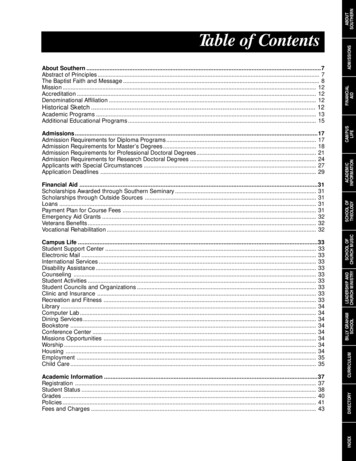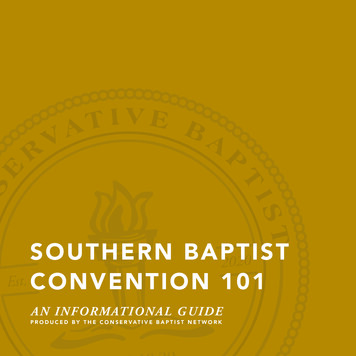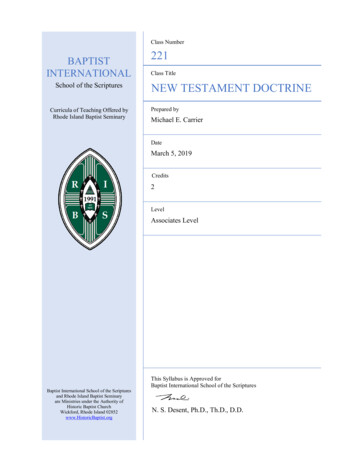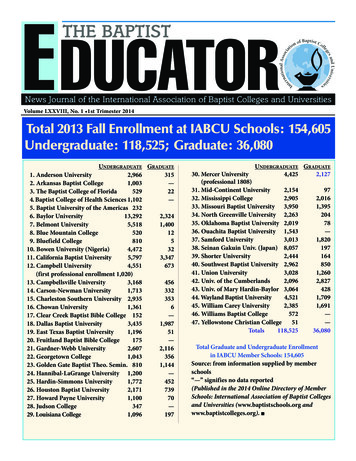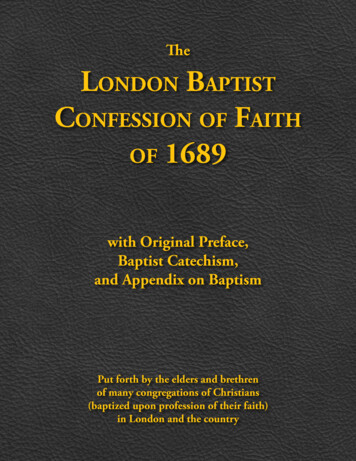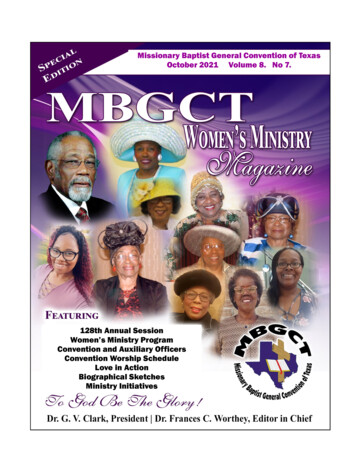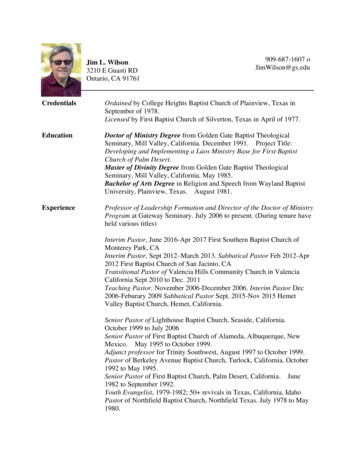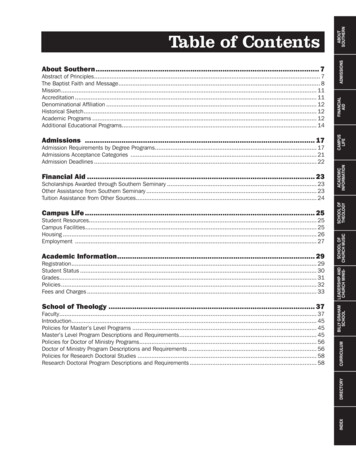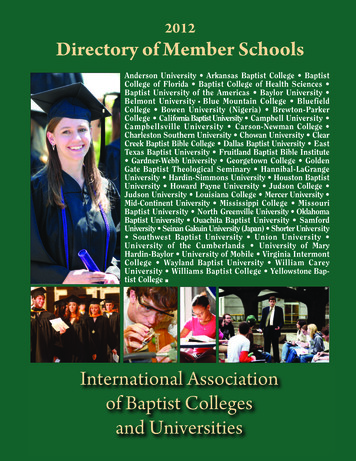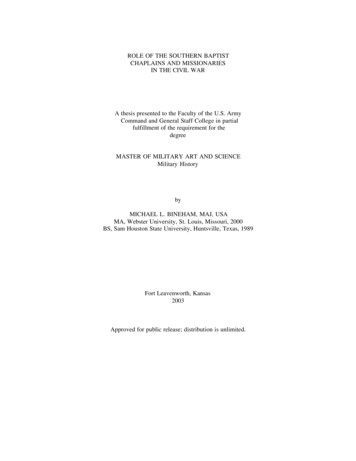
Transcription
ROLE OF THE SOUTHERN BAPTISTCHAPLAINS AND MISSIONARIESIN THE CIVIL WARA thesis presented to the Faculty of the U.S. ArmyCommand and General Staff College in partialfulfillment of the requirement for thedegreeMASTER OF MILITARY ART AND SCIENCEMilitary HistorybyMICHAEL L. BINEHAM, MAJ, USAMA, Webster University, St. Louis, Missouri, 2000BS, Sam Houston State University, Huntsville, Texas, 1989Fort Leavenworth, Kansas2003Approved for public release; distribution is unlimited.
MASTER OF MILITARY ART AND SCIENCETHESIS APPROVAL PAGEName of Candidate: Major Michael L. BinehamThesis Title: Role of the Southern Baptist Chaplains and Missionaries in the Civil WarApproved by:, Thesis Committee ChairColonel (Retired) Jack D. Kem, Ph.D. (candidate), MemberChaplain (Colonel) Joel W. Cocklin, D.Min., MemberLieutenant Colonel Betsey A. Riester, M.S.Accepted this 6th day of June 2003 by:, Director, Graduate Degree ProgramsPhilip J. Brookes, Ph.D.The opinions and conclusions expressed herein are those of the student author and do notnecessarily represent the views of the U.S. Army Command and General Staff College orany other governmental agency. (References to this study should include the foregoingstatement.)ii
ABSTRACTROLE OF THE SOUTHERN BAPTIST CHAPLAINS AND MISSIONARIES IN THECIVIL WAR, by MAJ Michael L. Bineham, 141 pages.Organized religion has played a significant role in warfare throughout history. From thetime Moses led the Israelites out of Egypt into the new Promised Land until 2001 and theundertaking of the Global War on Terrorism, religion in one form or fashion hasimpacted the individual soldier. The United States’ Civil War from 1861 to 1865 was nodifferent. The purpose of this thesis is to look at the events leading up to the Civil Warand the conflict itself from the viewpoint of the Southern Baptist denomination.Specifically, the thesis focuses on the reasons for the creation of the Southern BaptistConvention, as well as examines how the denomination supported the war effort. It looksat the wide range of individual contributions of the denomination’s chaplains,missionaries, evangelists and colporteurs. It also details how important the use ofreligious tracts were in ministering to soldiers. As we continue our Global War onTerrorism, the information contained within this paper should serve as a reminder tothose men and women at the Southern Baptist Seminaries that religious service to thearmy is still necessary and that it comes in many forms. As far as the human dimensionand the spiritual fitness of soldiers are concerned, what worked in 1863 is still applicablein 2003.iii
ACKNOWLEDGMENTSI must begin this portion by giving thanks to my Lord and Savior, Jesus Christ,for once again seeing me through a difficult situation. His willingness to bless my familyand me is a constant source of amazement and I am truly grateful for His love andcommitment to me.Next, I must try to formally recognize my mom and dad as well as my motherand sister-in-law. I appreciate everyone’s thoughts, prayers, and encouragement duringthis entire process. Any attempt to adequately acknowledge here the contributions of mywife, Lori, and my son, Ty, to the completion of this project will prove insufficient. Theyhave had to put up with me always having my nose in a book or me sitting for hours infront of a computer screen just to hear me turn around and complain. Nights, weekends,and holidays, precious time that could have been spent with them, was devoted to thisundertaking. Lori’s perseverance, eternal patience, and never-ending encouragementmotivated me to achieve something that I’ve always wanted to obtain.I would also like to thank Mr. Thomas A. Stubbs and Mr. George Hornickel, myhigh school history teachers for making the study of history interesting and exciting andfor challenging me to continue to pursue academic studies.I am extremely appreciative of my committee and their efforts to guide methrough this process. Not one of them ever failed to take time out of their extremely busyschedules to provide me with outstanding feedback, focus, advice, encouragement, andtechnical assistance. Thank you all for your help and mentorship during this past year.iv
Finally, I would like to thank Mrs. Alisha Sanders for her superb editorialassistance with my thesis. I must also mention and thank the CARL research staff, andespecially Mrs. Dorothy Rogers, for all their valuable help.v
TABLE OF CONTENTSAPPROVAL PAGE iiABSTRACT iiiACKNOWLEDGMENTS . ivCHAPTER1. INTRODUCTION 1Religious Aspects of the Civil WarResearch QuestionsDelimitationsScope of Study2. CONFEDERATE BAPTISTS 8Strife in the Baptist DenominationFormation of the Southern Baptist ConventionViews on Slavery, Secession, and War3. BAPTIST MINISTERS SERVING SOLDIERS. .21Military Chaplains, Missionaries, and EvangelistsStatus, Organizations, and DutiesCamp LifeImpact of Ministers4. SOUTHERN BAPTIST RELIGIOUS LITRATURE. .57National Biennal SessionsState Associations and ConventionsBibles/Tracts/ Newspapers/Hymnals5. CONCLUSION AND LESSONS LEARNED .80APPENDIXA. Biographical Information and Photos .85B. Roster of Ministers 93C. Soldiers’ Almanac . 99D. Sample Tracts . 111BIBLIOGRAPHY . 128INITIAL DISTRIBUTION LIST .134CERTIFICATION FOR MMAS DISTRIBUTION STATEMENT .135vi
CHAPTER 1INTRODUCTIONOrganized religion has played a significant role in warfare throughout history.From the time Moses led the Israelites out of Egypt into the new Promised Land until2001 and the Global War on Terrorism, religion in one form or fashion has impacted theindividual soldier. The United States’ Civil War from 1861 to 1865 was no different. TheCivil War changed the course of this nation and the role of organized religion was presentnot only on the home front but also prevalent in both armies. Some scholars have evenaccused church leaders on both sides, especially those in the North, of inciting theircongregations to a fever pitch, usually over the issue of slavery and states’ rights.Religious denominations and their influence were involved in all aspects of the war,perhaps even contributing to the start of the war, the conduct of the war, and ultimatelyreconstruction efforts. The Civil War was somewhat unique in that it largely pittedChristians against Christians, as opposed to Christianity against another religion. Both theNorth and the South emphatically believed that God was truly on their respective sides.Individual chaplains and their personal importance and influence varied from unit to unit.It is estimated the Union had approximately 2,300 to 3,000 chaplains serving in theArmy. The Confederate States of America (CSA) had between 600 and 1,000 membersparticipating as actual Army Chaplains.1 The chaplains as a group during the Civil Wardistinguished themselves, for either good or bad, along the total spectrum of soldierlyconduct, from Medal of Honor winners to those classified as scoundrels, charlatans andcowards. By and large, the majority religion of the common Civil War soldier was that ofProtestant Christianity. Of course other major faiths were represented--Catholics, Jews1
and even atheists. However, these combined for a relatively small portion of the entiresoldier population. These faiths were generally confined to ethnic related commands, theUnion Irish Catholics as well as the Confederate Catholic troops from Louisiana. Themainstream Protestant denominations enjoyed unprecedented cooperation throughout theconduct of the war.2 What is interesting to note is the denominational splits that occurredbased on geographic locales, which remain to this day.The purpose of this thesis is to look at the events leading up to the Civil War, thewar itself and the reconstruction efforts from the viewpoint of the Southern Baptistdenomination. Specifically, what was the reason for the creation of the Southern BaptistConvention? How did the Southern Baptist Convention support the war effort? Whatwere the denominational requirements that were placed on their chaplains andmissionaries? Where did the Southern Baptist chaplains and missionaries fit into theConfederate Chaplaincy? Did the convention provide chaplains or missionaries to theUnion forces? Who were some of the most prominent Southern Baptist chaplains andwhat were their contributions during and after the war? How did the denominationparticipate into the “Great Revival” that took place in the Confederate armies? What werethe some of the significant results that transpired as a result of the active participation ofthe Southern Baptists during the war?The political, moral, and economic issues that led up to the commencement of theCivil War didn’t spare spiritual institutions. It is truly a sad statement that seculardifferences of opinion and practices could not be settled short of an all out Civil War, butit is sadder still that differences could not be resolved within the religious community. Itis even ironic that most Southerners even blamed the Northern clergymen for inciting2
hostilities from their pulpits. Indeed, numerous, highly regarded abolitionist religiousleaders used their pulpits to decry the evils of slavery and pushed the issue to the brink ofwar. The three largest Protestant churches in the nation--Methodist, Baptist, andPresbyterian--all split prior to the Civil War. The Methodists were the first to break apart,followed by the Baptists in 1845, and finally by the Presbyterians. The Baptistdenomination had always had sectional differences between the businessmen of theNorth, the farmers of the West, and the planters of the South. Due to the fact that theBaptists were generally in the lower economic class, relatively few owned slaves.However, slavery prevailed as the most divisive issue within the denomination. Therewere other mitigating factors that contributed to a strained relationship, such as the desirefor stronger denominational unity than what was currently in place within the societyplan. The American Baptists had a society pattern in place, which means that they wereorganized into a separate society for each Christian ministry. The Southern leaders in thechurch wanted to change the current structure to be more of an associational type, whichmeans that one denominational body would encompass multiple Christian ministries. By1832 the three main ministries that were being supported under the society plan were theGeneral Missionary Convention, the Tract Publication and Distribution Society, and theHome Mission Society. The Baptist leadership in the South felt that the Northern-basednational societies were discriminating against the Southerners in the distribution ofmissionary appointments and in the meeting of needs of the membership. The slaveryissue was constantly being brought up as a source of contention during the nationalmeetings, along with other issues such as the lack of Southerners appointed to the homeand foreign fields, and the discipleship of church members. In 1839 the Southern3
churches even went to the extent of organizing their own Southern home mission body tomake up for the deficiencies, however, the newly created organization was short livedand folded after only three years. In 1844 it seems the final straw was placed upon theSouthern Baptist churches with the refusal to allow a Georgia slaveholder to be a homemissionary in his own state and an Alabama slaveholder to be a foreign missionary. Afterthis proclamation the Virginia Baptists called for a meeting of the Baptists of the South tomeet at the First Baptist Church in Augusta, Georgia, to talk about the issues concerningtheir membership. A decision was reached that more Christian work could beaccomplished by an organization in the South. On 10 May 1845, the Southern BaptistConvention was provisionally organized under a new constitution, which was ratified in1846 in Richmond, Virginia. The Southern Baptist leadership was quick to point out thatthe North and the South were still brethren, however, they felt more could beaccomplished with the new convention. The Southern Baptist Convention elected one setof board managers to supervise foreign missions and one to supervise home missions.The Northern and Southern Baptists still worked jointly on the Tract Publication andDistribution Society. Even though the Civil War disrupted all the programs of the newlyformed Southern Baptist Convention, it still experienced tremendous growth andexpansion in Christian ministries until 1891.3The major scope of this study will consist of the time period between 1861 and1865. In order to provide sufficient background information, it will be necessary to atleast research back to 1845 to discuss the issues and events surrounding the breakup ofthe American Baptist and the establishment of the Southern Baptist Convention. Theyears between 1845 and 1860 will also shed much light on the pervasive attitudes held by4
the majority of Southern Baptists on the issues of slavery and secession. The generalnature of study will revolve around the specific actions of the Southern BaptistConvention in regards to its instructions to its denominational chaplains, the funding ofchaplains and missionaries, and the convention’s efforts to support the Tract andPublication Ministry. The study will focus on the contributions of specific SouthernBaptist chaplains and the services they provided the individual soldiers and thecommand. This will not include information on how the convention addressed otherministries such as the Sunday School Board, foreign missions, relationships with otherdenominations, or its support of numerous other goodwill programs. The conclusion maylist the significant achievements by notable Southern Baptists after the end of hostilitiesin 1865. It will be important to see how the events of 1861 to 1865 affected, shaped, orchanged these men’s lives. In most cases their unique personal experiences during thewar profoundly molded who they were and what they did until they died.The Civil War was the most ferocious and bloody conflict in American history. Atthe same time it could be said that the Civil War was the most religious war in all history.J. William Jones in Christ in the Camp or Religion in Lee’s Army, points out: “Anyhistory of that army which omits an account of the wonderful influence of religion uponit which fails to tell how the courage, discipline and morale of the whole was influencedby humble piety and evangelical zeal of many of its officers and men would beincomplete and unsatisfactory.” With the increased popularity and explosion of Civil Warliterature in the past few decades there have been books and articles on the entire gamutof topics. One segment that has remained relatively untouched in comparison has beenthe study of the role that religion played during the conflict. There have been pieces5
written that deal with the topic of religious beliefs during that time period or even whatthe effects were on the individual denominations; however, they are relatively few innumber. To this point in research there are no extensive works that have been whollydedicated to the Southern Baptist Chaplains and missionaries. There are numerousdiaries, letter collections, memoirs, reports and biographies of individuals, but nothingthat covers in detail how they fit into the big picture of the Confederate chaplainacy. Thisstudy will establish the foundation for the creation of the Southern Baptist Conventionand how it chose to support the Confederate war effort through the hometown pastors,chaplains, and missionaries. It will look at how the Confederate chaplaincy was formed,the official requirements and duties expected of chaplains by the military, and civilianleadership. It will concentrate on the attitudes and beliefs of the common soldiers and thesenior officers towards the chaplains. It will also focus on how and why individualministers chose to serve in the military. The majority of Southern Baptist ministers signedup to serve as fighting soldiers or officers and served as “lay preachers” versus assumingthe official role of a military chaplain. The study will also focus on the differences orsimilarities between the eastern and western Confederate armies. It will determinewhether any Confederate Southern Baptists served as navy chaplains, hospital chaplainsor prison camp chaplains, and any significant acts of heroism performed by chaplains. Itwill also determine the role Southern Baptist Chaplains or missionaries played in theincrease of soldiers accepting Jesus Christ and their role in the “Great Revivals” whichswept through the Confederate armies.1Lawrence P. Fitzgerald, History of the Southern Baptist Chaplaincy (Atlanta:Southern Baptist Convention Home Mission Board, 1970), 28.6
2Steven E. Woodworth, While God is Marching On: The Religious World of CivilWar Soldiers (Lawrence: University Press of Kansas, 2001), ix-x.3Robert A. Baker, Southern Baptist Beginnings: Baptist Facts and Opinions(Nashville: Historical Commission of the Southern Baptist Convention, 1979), 11-12.7
CHAPTER 2CONFEDERATE BAPTISTSOn 10 May 1845, in Augusta, Georgia, the Southern Baptist Conventionprovisionally organized under a new constitution. This constitution was eventuallyratified in 1846 in Richmond, Virginia. This division of one of America’s largestprotestant religious denominations was a foreshadowing of events to come in the nation’shistory some fifteen years later. Unfortunately, the divisive slavery issue led to acontentious relationship between the Home Mission Society and the General Convention(foreign missions). This prolonged strained relationship between these two organizationsultimately led to the formation of the Southern Baptist Convention.1 The specific detailsof the divisive attitudes and sectional division that led to the eventual break-up deservemention. This background allows for a clearer understanding of how the SouthernBaptists approached the war. This analysis of the ideals and varied perspectives thatmotivated the religious community, regardless of their geographic locale, will lead to acomprehensive picture of the pre-Civil War environment that dominated America.Although in hindsight, the denominational split of the American Baptists seems tofall along the lines of secession, it very easily could have occurred differently. ManyBaptist publications and newspapers such as The Baptist Banner and Western Pioneerjustified denominational separation on the basis of a perceived neglect of the South bychurch leaders in the North. Baptist leaders in the South felt they were justified indemonstrating their displeasure with the current state of affairs. On some occasionsobjections were raised with an incomplete understanding of all the facts. Records indicatethe Home Mission Board attempted to provide an adequate number of workers to the8
Southern states however, the Board fell short of their recruiting goals. Evidently, goingto destitute communities in the inhospitable climate of the South was not appealing tomany of the qualified candidates desiring to minister in the home mission field.2 Evenwhen qualified individuals were willing to go, they demanded a great deal ofcompensation and generally went only to the largest cities such as New Orleans.In the 1830s, the Western portion of the country was starting to gain its ownidentity and subsequently began to push its own agenda for recognition. On the nationalscene, political leaders were beginning to view the country as East against the West. TheBaptist church leaders began to speculate that a denominational split could occur alongthose same lines. In 1833 and 1839 there were movements to test the feasibility of aWestern Baptist Convention and a Western Baptist Home Mission Society, respectively.Had the issue of slavery not arisen, this may in fact have been where the denominationalsplit would have occurred.3 In the 1830s the exact nature of the split of the AmericanBaptists, if there was to be one at all, was yet to be determined when the abolitionmovement began to become more of a driving force in the North. Would the split begeographical--North and South or East and West--or ideological, based on the principleof slaveholders and nonslaveholders? These organizational questions were extremelydivisive and were also negatively impacting the effectiveness of the denomination’s workin the foreign and home mission fields.In 1834, even the English Baptists, based in London, weighed in on the issue ofslavery. They had missionaries that led the way for emancipation of slaves on the islandof Jamaica in 1833. A group of London ministers wrote to the American Baptists,headquartered in Boston, in an attempt to pressure the church leadership to push for9
slavery reforms. The American Baptist’s corresponding secretary, Dr. Lucius Bolles,responded to the London ministers by pointing out that slavery was introduced into thecolonies against the wishes of the colonists, and that some progress was already beingmade in moving away from the institution. In his letter, he eloquently captured thegeneral feelings and the complexity of the issues of both sides of the Baptists. He stated:There is now a pleasing degree of Union among the multiplying thousands ofBaptists throughout the land. . . . Our Southern brethren are liberal and zealous inthe promotion of every holy enterprise for the extension of the gospel. They aregenerally, both ministers and people, slaveholders, not because they think slaveryright, but because it was firmly rooted long before they were born and becausethey believe that slavery cannot be instantly abolished. We are confident that agreat portion of our brethren at the South would rejoice to see any practicablescheme devised for relieving the country from slavery. We have the best evidencethat our slave-holding brethren are Christians, sincere followers of the Lord Jesus. . . We cannot, therefore, feel that it is right to use language or adopt measureswhich might tend to break the ties that unite them to us in our General Conventionand in numerous other benevolent societies. We have presented theseconsiderations, dear brethren, as among the reasons which compel us to believe,that it is not the duty of the Baptist General Convention, or the Board of Missions,to interfere with the subject of slavery.4Many believe that if all the board members of the American BaptistDenomination subscribed to the views espoused by Dr. Bolles and displayed an attitudeof brotherly understanding and patience, there may have been no denominational split.The abolitionists were extremely active and forcefully persistent in getting their messageout. The abolitionists’ first objective was to get individual churches and local associationsto make a statement condemning the institution of slavery. Once that goal wasaccomplished they encouraged those churches to pursue policies of non-fellowship withthose individuals or organizations that had even the slightest of connections to slavery. In1840, the Free Baptist Foreign Missionary Society was formed in the Northeast portion ofthe country and it was founded on abolition principles. The most militant abolitionists10
formed an organization called the American and Foreign Baptist Missionary Society.This group desired to conduct its own form of missionary work, both at home andabroad.5In 1840, the abolition issue was beginning to be felt even among the Baptists inthe South. In September the Alabama Convention appointed a committee to makerecommendations concerning the issue of abolition. The committee was composed ofJesse Hartwell, B. P. Bestor, W. C. Crane, J. H. DeVotie, and M. P. Jewett. Thecommittee stated, “Abolitionism was unscriptural, against the national constitution,against the peace and prosperity of the churches, and dangerous to the permanency of theUnion.” The committee also recommended that money should be donated only to theBoard of Foreign Missions and the American and Foreign Bible Society upon providingevidence that they were not involved with antislavery movement. The GeneralConvention calmed some of the Southern fears by making an official publicannouncement of neutrality on the issue of slavery.Abolitionism was initially feared and hated in both the North and the South,mostly because the abolitionist pushed an agenda of “non-tolerance.” The abolitionist’sattitudes, rhetoric and actions gradually moved towards the more militant and hostile endof the scale. Many church members prescribed to the practice of fellowshipping with oneanother despite their vastly differing opinions on the issues of slavery and abolition.There was a desire for the moderates--both North and South--to bond together and forcethe abolitionists to withdraw totally from the American Baptist General Convention andform their own organizations.11
In 1844, the Georgia Baptist Convention nominated the Reverend J. E. Reeve toserve as a missionary to the Indians. The approval authority for this action was theexecutive board of the Home Mission Society; however the board refused to appointReverend Reeve, a slaveholder, as a missionary. This was just one more action thatappeared to be unjustified by a body that was supposedly neutral.6The insult to Reverend Reeve and the Georgia Baptist Convention was the laststraw and prompted several of the Southern state associations to take swift and finalactions. In the end the decision was to split from the American Baptists. In an effort towin as many new Baptist members as possible, much consideration was given as to thenaming of the new convention. The Southern and South-West Convention was suggestedas an organizational name, however, it was decided the “Southern Baptist Convention”would be comprehensive enough, and so it was adopted.On 10 May 1845, the provisional constitution was adopted, and Dr. William B.Johnson was elected as the first president of the Southern Baptist Convention. He wasone of the sharpest minds among Southern Baptists in 1845 and previously had beenpresident of the South Carolina Baptist Convention. He viewed the denominational splitas being similar to Paul’s second missionary journey. On that trip there was anunresolved disagreement between Paul and Barnabas. Subsequently they separated fromeach other and the outcome was that “two lines of service were opened for the benefit ofthe churches.” He wrote an address to the public in a document dated 12 May 1845stating that a painful division had taken place between the American Baptists. He wasquick to point out that the split was not over doctrinal issues, but was more a matter ofadministrative policies. Dr. Johnson stated:12
At the present time it involves only the Foreign and Domestic Missions of thedenomination. Northern and Southern Baptist are still brethren. They differ in noarticle of the faith. They are guided by the same principles of gospel order.7In 1860, the Southern Baptist denomination was the second largest group ofProtestants in the South, with well over 600,000 members. From 1845 to 1860 theSouthern Baptist membership grew from 365,346 to 645,218. Comparatively speaking,this 4.79 percent annual increase in membership was drastically lower than the AmericanBaptists’ growth from 1814 to 1845, which was at 7.20 percent. The number of SouthernBaptist churches increased from 4,395 in 1845 to 7,760 in 1860, while the number ofassociations increased from 213 to 316 during that same period. On the state level,associations increased from 9 to 13. In 1860 Southern Baptists comprised 5.29 percent ofthe total population, compared with 5.03 percent in 1845.8How could such like-minded individuals be so opposite in their thinking on theissue of slavery? Of all the national issues, slavery caused the most division in theAmerican fabric because it encompassed a plethora of hotly contested issues; political,economic, social, moral, and religious, simultaneously. Many of the prominent attitudesheld by Christians of that day were based on their regional environments and theirdiffering interpretations of the Bible. The conflict of sectionalism between theindustrialized North and a largely agrarian South had been much discussed and debated.When it came to the issue of slavery, Southern Baptist thinking was along the same linesas most other Southern evangelicals. Most Southern Protestant denominations believedthat human bondage was divinely ordained; an attack on the institution of slavery equatedto an attack on the authority of God. Southerners regarded slavery as absolutely essentialto a prosperous South, and felt that the abolishment of slavery would therefore not only13
trample on their rights but also threaten all Southerners and all of their institutions.Northern Baptists saw slavery as a threat to the nation’s political institutions. Theybelieved it corrupted the Union and had to be contained in the South. Only after thehostilities began in the Civil War did the vast majority of Northerners begin to seeemancipation as a moral necessity.9As a whole Southern ministers were very adept at making arguments in theirpreachings and writings condoning the institution of slavery. Typical biblicaljustifications for slavery include the belief that Africans were descendants of Ham, andtherefore were a cursed people. Others believed Christians were obligated to follow apractice God had allowed in both the Old and New Testaments. One line of thinking wasthat slavery was actually a blessing for the people from Africa much like it had been forthe Israelites when their captivity had saved them from starvation and preserved theirnation. Many Baptists in Texas saw slavery as a means to spread the gospel to theAfricans in t
missionary in his own state and an Alabama slaveholder to be a foreign missionary. After this proclamation the Virginia Baptists called for a meeting of the Baptists of the South to meet at the First Baptist Church in Augusta, Georgia, to talk about the issues concerning their membership. A decision was reached that more Christian work could be


